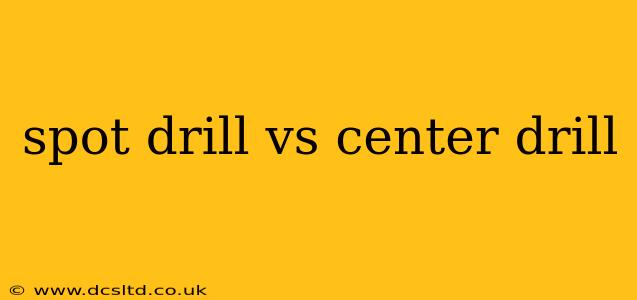Choosing between a spot drill and a center drill often leaves machinists and DIY enthusiasts puzzled. While both tools create a starting point for drilling, they differ significantly in their design, application, and the resulting hole. This detailed comparison will clarify their distinctions and help you choose the right tool for your project.
What is a Spot Drill?
A spot drill is a specialized tool with a conical point and relatively short overall length. Its primary function is to create a small, shallow indentation or "spot" on the workpiece's surface. This indentation serves as a precise starting point for a larger drill bit, preventing the larger bit from wandering and creating an inaccurate or uneven hole. Spot drills are typically made of high-speed steel (HSS) or carbide, ensuring durability and longevity. The angle of the cone is usually much less than 90 degrees.
Key Characteristics of a Spot Drill:
- Conical point: Creates a precise indentation, not a full-depth hole.
- Short length: Ideal for creating starting points without penetrating deeply into the material.
- Precise starting point: Prevents drill bit wander, particularly beneficial in thin materials.
- Used for: Primarily establishing a starting point for larger drill bits.
What is a Center Drill?
A center drill combines a drill bit with a 60-degree point and a countersinking function. It creates a small pilot hole while simultaneously forming a countersink to accommodate the head of a screw or rivet. This is a crucial aspect differentiating it from the spot drill. The countersink helps hold the screw or rivet in place and prevents it from spinning freely. Center drills are also typically made from HSS or carbide.
Key Characteristics of a Center Drill:
- 60-degree point: Creates a small pilot hole and a countersink in a single operation.
- Longer length: Compared to a spot drill, allows for slightly deeper penetration.
- Countersinking ability: Creates a countersink for screws or rivets, ensuring proper seating.
- Used for: Creating a small pilot hole and countersink simultaneously.
Spot Drill vs. Center Drill: A Direct Comparison
| Feature | Spot Drill | Center Drill |
|---|---|---|
| Point Shape | Conical | 60-degree point with countersink |
| Primary Function | Creates a precise starting point | Creates pilot hole and countersink |
| Hole Depth | Very shallow indentation | Small pilot hole with countersink |
| Application | Preventing drill bit wander | Preparing for screws, rivets, or bolts |
| Countersink | No | Yes |
Which One Should I Use?
The choice between a spot drill and a center drill depends entirely on your application:
-
Use a spot drill when: You need a precise starting point for a larger drill bit, especially in thin materials where wandering is a major concern. The shallow indentation helps to maintain accuracy and prevent the larger bit from slipping.
-
Use a center drill when: You are preparing a hole for a screw, rivet, or bolt, and require both a pilot hole and a countersink. This eliminates the need for separate operations, increasing efficiency.
What materials are they used on?
Both spot drills and center drills are versatile and can be used on a variety of materials, including:
- Metals: Steel, aluminum, brass, etc.
- Plastics: Many types of plastics
- Wood: Although less common, they can be used in certain wood applications.
How to use a spot drill and center drill effectively?
Both tools require proper clamping and steady hand pressure. Always ensure appropriate speed and feed settings for the material being drilled to prevent damage to the tool or workpiece. Lubrication can also increase tool life and improve hole quality.
This comprehensive overview should provide you with a clear understanding of the differences between spot drills and center drills, allowing you to make informed decisions when selecting the right tool for your specific needs. Remember, precision and proper technique are key to achieving optimal results with both tools.
